Heptylene
Hazard to Others
  
Posts: 319
Registered: 22-10-2016
Member Is Offline
Mood: No Mood
|
|
tris(4-nitrophenyl)methanide, an easily formed blue carbanion
I just finished the synthesis of tris(4-nitrophenyl)methane, an interesting molecule which can be deprotonated by sodium hydroxide to form a very
strongly coloured carbanion (tris(4-nitrophenyl)methanide). Below I will give the complete procedure to prepare the compound starting from
bromobenzene and ethyl benzoate. At the end I’ll show the formation of the carbanion in different solvents.
The full sequence is bromobenzene/ethyl benzoate to triphenylmethanol, then triphenylmethane, then nitration to the title compound.
1. Triphenylmethanol
To a 500 3-neck RBF equiped with a reflux condenser and a thermometer and a stopper there was added magnesium turnings (6.10 g, 251 mmol, 2.51 eq.).
The apparatus was connected to a vacuum pump (5 torr) and heated strongly. After it had cooled to room temperature, argon gas was let in and a crystal
of iodine was added. The iodine was heated to sublimate it on top of the magnesium. There was then added in 5 protions a solution of bromobenzene
(33.0 g, 210 mmol, 2.10 eq.) in anhydrous THF (88 g). The reaction started immediately and the THF started to boil. The exotherm was controlled by
applying a cold water bath and the bromobenzene was added such that the solution boiled without external heat. At the end of the addition the reaction
was further stirred for 30 minutes to ensure no bromobenzene was left. There was added ethyl benzoate (15.01 g, 100 mmol. 1 eq.) in THF (15 g) one
milliliter at a time such that the reaction temperature was 50 °C throughout. After addition the reaction was left stirring for 1 hour.
The reaction was then cautiously quenched with water (20 ml), followed by 10 M HCl (20 ml) and stirred for 30 minutes. The THF was removed by
distillation and the product was extracted with toluene, washed with NaHCO3, water and then dried of Na2SO4. The toluene was removed under vacuum and
the product (an orange stick paste) was washed with heptane twice on a filter funnel which got rid of the orange colour. The product was finally
recrystallized from isopropyl alcohol twice (2x100 ml) to yield 9.96 g (38 %) of a slightly yellowish crystalline powder. MP = XXX.
2. Triphenylmethane by reduction with hypophosphrous acid and iodine
2.1 Preparation of hypophosphorous acid solution [1]
To sodium hypophosphite monohydrate (32.1 g, 0.3 mol, 1 eq.) there was added 10 M HCl (30 ml, 0.3 mol, 1 eq.) at once, and the mixture was stirred for
20 minutes in a hot water bath (about 70 °C). The mixture was cooled in an ice bath and filtered to remove precipitated NaCl. The viscous filtrate
had a density of 1.265 g, which should corresponds to about 55 % w/w assuming only hypophosphorous acid is in solution. The product is used in huge
excess in the next reaction anyway.
2.2 Reduction of triphenylmethanol to triphenylmethane [2]
To a stirred suspension of triphenylmethanol (3.27 g, 12.6 mmol, 1 eq.) of acetic acid (40 ml, half of what is used in the reference) there was added
iodine (3.15 g, 12.4 mmol, 0.99 eq.). The mixture was stirred without complete dissolution of either products and there was added hypophosphrous acid
solution (6.5 ml, density 1.265 g assumed to be 55 % w/w, 68 mmol, 5.4 eq.) slowly with cooling, although no exotherm was observed. The mixture was
heated and stirred on a 60 °C water which resulted in the dissolution of almost everything. The heating was continued for 24 hours at which point a
lot of precipitated had appeared. The reaction mixture was diluted with water (100 ml) and extracted with heptane (about 50 ml in total if I recall
correctly). The heptane was removed by distillation to yield an off-white powder in almost quantitative yield which was used without purification.
3. tris(4-nitrophenyl)methane by mixed acid nitration of triphenylmethane [3]
To freezer-cold concentrated nitric acid (14 ml of about 15 M solution, 0.21 mol, 18 eq.) there was added crude triphenylmethane (2.83 g, 11.6 mmol,
1 eq.) with stirring. The reaction mixture was placed in an ice/salt bath and concentrated sulfuric acid (14 ml of 96 % solution) was added dropwise
over 15 minutes such as to maintain the temperature of the mixture between -5 and 0 °C. The mixture was stirred for a further 1h30 after which gummy
red solids had separated from the liquid. The mixture was then stirred in a water bath at 35 °C for 45 minutes. Heating at 35 °C caused the red
solids to mostly disappear and an oil to appear on top of the acid mixture. The mixture was poured in 250 ml of water with strong stirring, and the
resulting solids were filtered and washed with water. The solids were dried at 70 °C, boiled with acetic acid for 30 minutes to dissolve the mono-
and dinitrated side-products but not the desired product (per the reference) and filtered while hot. The yellow solid melted at 206 °C and was
recrystallized from boiling toluene to yield 1.01 g (23 %) of white powder melting sharply at 213 °C (lit .211-213 °C from toluene [3], although
metling points as high as 217 °C have been reported [4])
Now the carbanion : There was added a very small amount (too small to weigh) of the product to about 2 ml each of methanol, acetonitrile, THF, DCM,
toluene and triethylamine in small vials. There was then added about 3 drops of concentrated NaOH in methanol to each vial which caused a colour
change.
In the case of methanol, a slight purple color appeared, which did not increase immediately upon adding more base. In all other cases a very strong
blue or purple coloration appeared. The colour faded within seconds in acetonitrile. In the other solvents, the blue color had faded to yellow after
an hour. Pictures are attached.
It is only an assumption that the colour observed is that of the carbanion, so if you have other theories I'd like to hear them.
References :
[1] Chemplayer’s video on the preparation of hypophosphorous acid solution
[2] Gordon, P. E. ; Fry, A. J., Tetrahedron Lett., 2001, 42 (5), pp. 831-833, DOI : 10.1016/S0040-4039(00)02159-6
[3] McFarland, J. W. ; Lenz, D. E. ; Grosse, D. J., J. Org. Chem., 1966, 31 (11), pp. 3798-3800, DOI : 10.1021/jo01349a072
[4] Bickelhaupt, F. et al., Tetrahedron, 1976, 32, pp. 1921-1930, DOI : 10.1016/0040-4020(76)85198-8
The pictures in order are:
1. The reaction scheme
2. The final product tris(4-nitrophenyl)methane
3. The product in different solvents. From left to right: methanol, acetonitrile, THF, DCM, toluene and triehtylamine.
4. The product in those solvents a few seoncds after addition of base.
5. After a few minutes
6. After 1 hour.
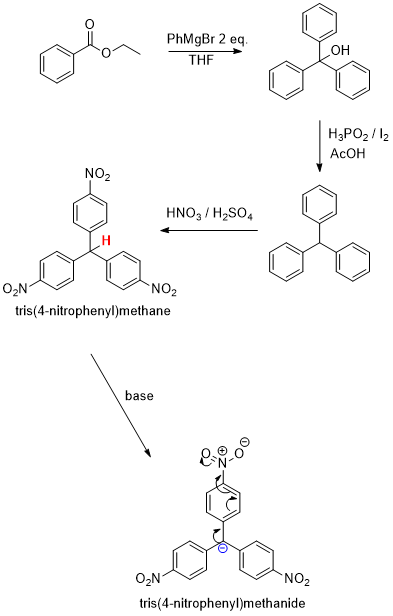 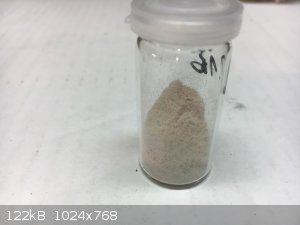
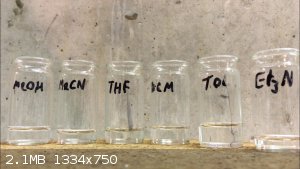 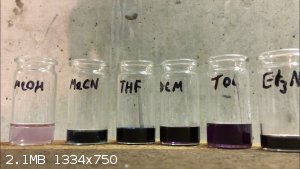
[Edited on 19-8-2018 by Heptylene]
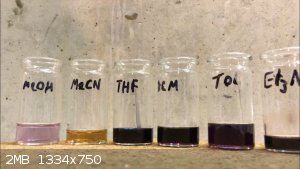 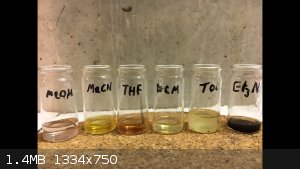
|
|
|
fusso
International Hazard
    
Posts: 1922
Registered: 23-6-2017
Location: 4 ∥ universes ahead of you
Member Is Offline
|
|
The solutions look very dark. Maybe try dilute the solutions to make the colour lighter?
Maybe colour fade is due to decomposition?
|
|
|
Heptylene
Hazard to Others
  
Posts: 319
Registered: 22-10-2016
Member Is Offline
Mood: No Mood
|
|
Color in more dilute solution
I tried dissolving an extremly small amount (much less than 1 mg) in DCM and added base as before. The solution became very dark purple so I diluted
it some more and obtained the result shown in the picture. The solution faded away in about a minute this time. So dilute solution fade more rapidly.
I wonder if oxygen is playing a role in the decomposition...
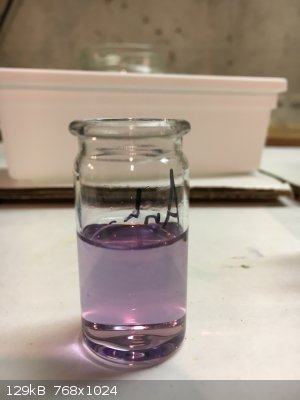
|
|
|
fusso
International Hazard
    
Posts: 1922
Registered: 23-6-2017
Location: 4 ∥ universes ahead of you
Member Is Offline
|
|
Then try capping the vial tightly to see if the
solution decompose without O2.
|
|
|
UC235
National Hazard
   
Posts: 565
Registered: 28-12-2014
Member Is Offline
Mood: No Mood
|
|
I'm sure that oxygen or perhaps CO2 is playing a role in quenching the carbanion. In the case of Acetonitrile, it's probably reacting to the
N-(tris(p-nitrophenyl)methyl)acetamide.
Given the very small quantity of triphenylmethane derivative, I don't think capping the vial would do much to inhibit the fading. You'd want to
thoroughly degas the solutions beforehand and run it under nitrogen.
[Edited on 19-8-2018 by UC235]
|
|
|
Heptylene
Hazard to Others
  
Posts: 319
Registered: 22-10-2016
Member Is Offline
Mood: No Mood
|
|
I guess I could try degassing some THF and compare the decomposition rate with that in non-degassed solvent.
How should I go about degassing THF? Bubbling argon through it? If so for how long?
Adding a piece of sodium to dry THF should get rid of oxygen forming sodium oxide. Then adding a drop of methanol should convert the sodium oxide to
hydroxide and methoxide. I could then just remove the sodium to get a solution containing so oxygen to which I could add the
tris(4-nitrophenyl)methane and purge with argon.
My hope is that water or alcohols don't play a role in the decomposition of the carbanion, otherwise I will need a different base than hydroxide or
methoxide.
Anyway I won't have access to my lab for a while so experiments will have to wait.
|
|
|
|